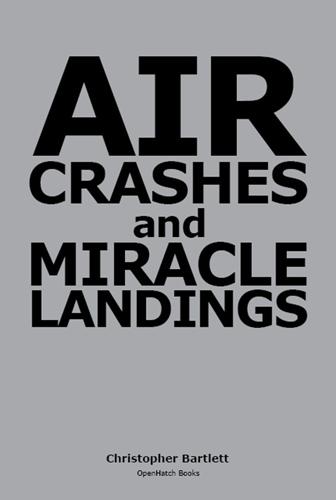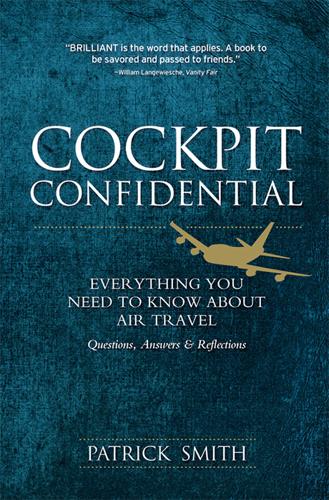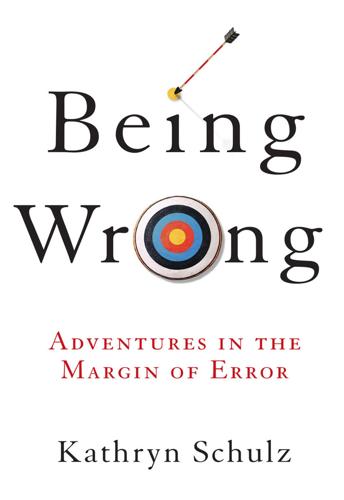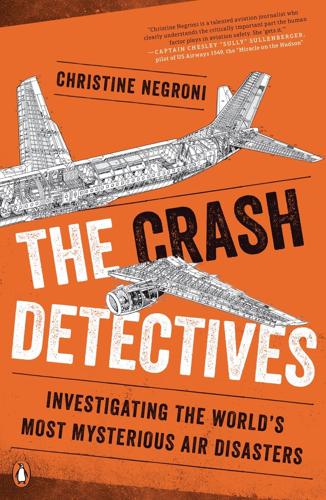Tenerife airport disaster
description: runway collision at Los Rodeos Airport, Tenerife, 1977-03-27
10 results

Air Crashes and Miracle Landings: 60 Narratives
by
Christopher Bartlett
Published 11 Apr 2010
PREFACE ACKNOWLEDGEMENTS INTRODUCTION CHAPTER 1 LOSS OF POWER OVER WATER THE AMELIA EARHART MYSTERY (Howland Island 1937) BA 747 LOSES ALL POWER (Indian Ocean 1982) HIJACKED ETHIOPIAN 767 DITCHES (Comoros 1996) 80-MILE ATLANTIC GLIDE (Azores 2001) US AIRWAYS FLIGHT 1549 (Hudson River 2009) CHAPTER 2 LOSS OF POWER OVER LAND CONSCIENTIOUS CREW FORGET FUEL REMAINING (Portland 1978) GLIDING EXPERIENCE SAVES THE DAY (Gimli, Canada 1983) AVIANCA FLIGHT 52 MISSES LAST CHANCE (New York 1990) CHARTS DID NOT SHOW BUILT-UP AREAS (London 2004) BA 777 STAGGERS INTO HEATHROW (London 2008) CHAPTER 3 RUNWAY OVERRUNS 100-MPH QANTAS OVERRUN (Bangkok 1999) AIR FRANCE A340 GUTTED BY FIRE (Toronto 2005) CHAPTER 4 MID-AIR COLLISIONS & TCAS TWO JAL AIRCRAFT IN NEAR MISS (Japan 2001) DHL CARGO 757 & TU-154 COLLIDE (Lake Constance 2002) CHAPTER 5 GROUND COLLISIONS KLM 747 ENCOUNTERS PAN AM 747 ON TAKEOFF (Tenerife 1977) SIA 747 TAKES OFF ON DISUSED RUNWAY (Taipei 2000) FRENCH AIRLINER CLIPS UK FREIGHTER (Paris CDG 2000) SAS MD-87 ENCOUNTERS CESSNA ON TAKEOFF (Milan 2001) CHAPTER 6 NO CONTROLLABILITY DC-10 CARGO DOOR OPENS INFLIGHT (Windsor/Detroit 1972) PACKED DC-10 CRASHES MINUS 6 PASSENGERS (Paris 1974) TEXTBOOK SPEED SEALS DC-10 FATE (Chicago 1979) JL123, WORST SINGLE AIRCRAFT DISASTER (Japan 1985) UNCONTROLLABLE DC-10’S MIRACLE LANDING (Sioux City 1989) DHL AIRBUS MANEUVERED BY ENGINE POWER (Baghdad 2003) CHAPTER 7 FIRE & SMOKE FIRE IN VARIG 707 TOILET ON APPROACH TO ORLY (Paris 1973) TRISTAR DELAYS EVACUATION (Riyadh 1980) 737 STOPS WITH FIRE UPWIND (Manchester, UK 1985) 737 PILOTS SHUT DOWN WRONG ENGINE (Kegworth, UK 1989) TWA-800, CENTER FUEL TANK EXPLODES (JFK-Outbound 1996) HAZMAT VALUJET (Everglades, Florida 1996) SWISSAIR-111 ONBOARD FIRE (JFK-Outbound 1998) SUPERSONIC CONCORDE (Paris CDG 2000) CHAPTER 8 PILOT SICK, SUICIDAL, OR INAPPROPRIATE RESPONSE BEA TRIDENT CAPTAIN’S HEART ATTACK (Staines, London 1972) WAS EGYPTAIR FLIGHT 990 SUICIDE?
…
Similarly, Disasters in The Air—The Truth about Mysterious Air Disasters[2] by Jan Bartelski was of great value in making me look again at the assumptions that had generally been made regarding some notorious disasters, and notably the worst ever multi-aircraft disaster in which two 747 jumbos collided on the ground in fog at Tenerife in 1977. Some of the episodes of the excellent TV series entitled Air Crash Investigation—also called ‘MAYDAY’ in some countries—broadcast on the National Geographic Channel, yielded some useful new insights when the author was half-way through this book. Besides bringing events to life much as he has tried to do here, the highly successful series has aroused the interest of many.
…
Newer versions of TCAS are intelligent enough to reverse their commands should they find that one of the aircraft is not complying, as happened in this sad case, which anyway has made pilots all over the world more aware of the obligation to comply. CHAPTER 5 GROUND COLLISIONS KLM 747 ENCOUNTERS PAN AM 747 ON TAKEOFF (Tenerife 1977) Worst-Ever Multi-aircraft Disaster This, the worst-ever multi-aircraft disaster, was similar to so many other disasters in that it involved a whole list of factors and strokes of bad luck, and as is usual would not have happened had any one of them been absent. [KLM Flight 4805 and Pan Am Flight 1736] One Sunday afternoon in March 1977, a terrorist bomb and the possibility of another had made the authorities temporarily close Las Palmas Airport in the Spanish Canary Islands.

Why Airplanes Crash: Aviation Safety in a Changing World
by
Clinton V. Oster
,
John S. Strong
and
C. Kurt Zorn
Published 28 May 1992
For the 1983-1989 period, the charter airline fatal accident rate was about twice that of scheduled airlines, and death risk was about 2.7 times worse than scheduled service, both of which represent improvements in absolute terms as well as relative to scheduled service. The high load factors on charter operations are reflected in the large number of fatalities per accident. As mentioned previously, the world's worst air disaster involved the on-ground high speed collision of KLM and Pan Am charter flight at Tenerife in 1977. In fact, six of the fifteen worst fatal accidents between 1977 and 1989 involved charter airlines. However, Spantax was the only charter operator to be involved in more than one fatal accident over the period. There is no apparent geographic pattern in the charter accidents. THE CAUSES OF INTERNATIONAL FATAL ACCIDENTS Information from ICAO and from additional public sources can be used to gain some insight into the causes of world airline accidents.

Cockpit Confidential: Everything You Need to Know About Air Travel: Questions, Answers, and Reflections
by
Patrick Smith
Published 6 May 2013
The FAA’s most valuable contribution to the problem might be something they’ve already done: stirred up awareness. When it comes right down to it, the best way to prevent collisions is for pilots and controllers to always be conscious of their possibility. Meanwhile, not to close on a morbid note, but I’ll remind you that aviation’s worst-ever catastrophe, at Tenerife in 1977, involved two 747s that never left the ground (see Tenerife story). What were your experiences on September 11, and how, from a pilot’s take, has flying changed since then? Among my vivid memories of that morning is that of the enormous black cockroach I saw crawling across the platform of the Government Center subway station at 7:00 a.m. while waiting for the train that would take me to Logan Airport.

Skygods: The Fall of Pan Am
by
Robert Gandt
Published 1 Mar 1995
The 747, which was emerging as the new flagship, established itself as the safest airliner ever operated by Pan Am. Not a single life would ever be lost in a flying accident with a Pan Am 747*. Pan American went on to establish a safety record that was the envy of the industry. * In neither of two fatal 747 disasters—the bombing of PA 103 in 1988 and the runway collision with a KLM 747 at Tenerife in 1977—was the 747 or the Pan Am crew held to blame. Chapter Twelve Vietnam Ton Son Nhut Air Base, Saigon May 1968 What the hell are we doing here? That was what Rob Martinside wondered, standing beneath the broad wing of the jetliner. He squinted in the bright sun. Across the sprawling ramp he could count six more tall tails bearing the blue Pan Am emblem.

The Checklist Manifesto: How to Get Things Right
by
Atul Gawande
Published 2 Jan 2009

The Power of Habit: Why We Do What We Do in Life and Business
by
Charles Duhigg
Published 1 Jan 2011
In the wake of that tragedy, the organization was able to overhaul how it enforced quality standards.6.40 Airline pilots, too, spent years trying to convince plane manufacturers and air traffic controllers to redesign how cockpits were laid out and traffic controllers communicated. Then, a runway error on the Spanish island of Tenerife in 1977 killed 583 people and, within five years, cockpit design, runway procedures, and air traffic controller communication routines were overhauled.6.41 In fact, crises are such valuable opportunities that a wise leader often prolongs a sense of emergency on purpose. That’s exactly what occurred after the King’s Cross station fire.

Same as Ever: A Guide to What Never Changes
by
Morgan Housel
Published 7 Nov 2023
Other countries thought it would be contained (standard denial) and didn’t act fast enough (bureaucracy). We weren’t prepared (overoptimism) and could respond only with blunt-force lockdowns (panic, do what you gotta do). None of those on their own are surprising. But combined they turned into a disaster. The Tenerife airport disaster in 1977 is the deadliest aircraft accident in history. The error was stunning. One plane took off while another was still on the runway, and the two Boeing 747s collided, killing 583 people on a runway on the Spanish island. In the aftermath authorities wondered how such an egregious catastrophe could occur.

Being Wrong: Adventures in the Margin of Error
by
Kathryn Schulz
Published 7 Jun 2010
For a detailed account, see the Netherlands Aviation Safety Board’s final report on the accident (one of the two planes involved was a KLM flight; hence the involvement of the Dutch authorities), Final Report and Comments of the Netherlands Aviation Safety Board of the Investigation into the Accident with the Collision of KLM Flight 4805, Boeing 747–206B, PH-BUF, and Pan-American Flight 1736, Boeing 747–121, N746PA, at Tenerife Airport, Spain, on 27 March 1977 (available online at http://www.project-tenerife.com/nederlands/PDF/finaldutchreport.pdf). reducing significant commercial aviation accidents. National Transportation Safety Board Aviation Accident Statistics, Table 2: Accidents and Accident Rates by NTSB Classification, 1988–2007, 14 CFR 121 (available at http://www.ntsb.gov/aviation/Table2.htm).

Machines of Loving Grace: The Quest for Common Ground Between Humans and Robots
by
John Markoff
Published 24 Aug 2015
His researchers design applications that can monitor a doctor and patient or other essential conversation, offering support so as to eliminate potentially deadly misperceptions. In another application, his research team maintains a book of morbid transcripts from plane crashes to map what can go wrong between pilots and air traffic control towers. The classic and tragic example of miscommunication between pilots and air traffic control is the Tenerife Airport disaster of 1977, during which two 747 jetliners were navigating a dense fog without ground radar and collided while one was taxiing and the other was taking off, killing 583 people.18 There is a moment in the transcript where two people attempt to speak at the same time, causing interference that renders a portion of the conversation unintelligible.

The Crash Detectives: Investigating the World's Most Mysterious Air Disasters
by
Christine Negroni
Published 26 Sep 2016